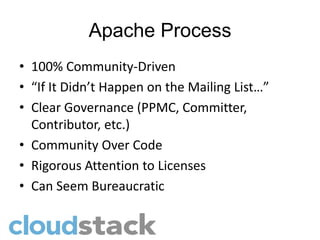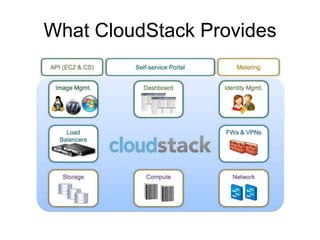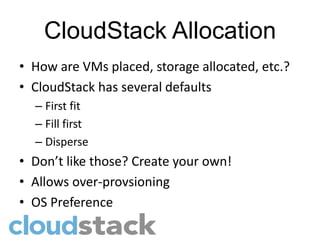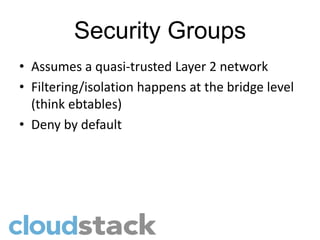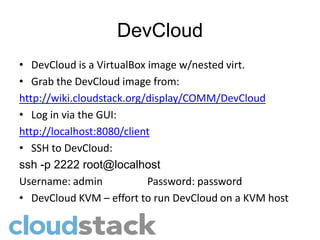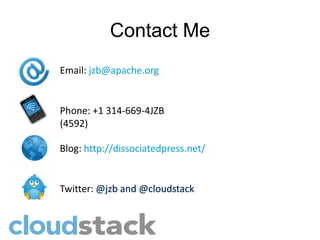Apache CloudStack from API to UI
- 1. Apache CloudStack: From API to UI Joe Brockmeier PMC Member Apache CloudStack [email protected] Twitter: @jzb | Freenode: jzb
- 2. Five Six Characteristics of Clouds • On-Demand Self-Service • Broad Network Access • Resource Pooling • Rapid Elasticity • Measured Service • API Access
- 3. Cloud Service Models USER CLOUD a.k.a. SOFTWARE AS A SERVICE Single application, multi-tenancy, network-based, one-to-many delivery of applications, all users have same access to features. Examples: Salesforce.com, Google Docs, Red Hat Network/RHEL DEVELOPMENT CLOUD a.k.a. PLATFORM-AS-A-SERVICE Application developer model, Application deployed to an elastic service that autoscales, low administrative overhead. No concept of virtual machines or operating system. Code it and deploy it. Examples: VMware CloudFoundry, Google AppEngine, Windows Azure, Rackspace Sites, Red Hat OpenShift, Active State Stackato, Appfog SYSTEMS CLOUD a.k.a INFRASTRUCTURE-AS-A-SERVICE Servers and storage are made available in a scalable way over a network. Examples: EC2,Rackspace CloudFiles, OpenStack, CloudStack, Eucalyptus, OpenNebula
- 5. What is Apache CloudStack? • Open Source (Apache-Licensed) IaaS • Community of Users and Providers • Written in Java* • Provides a Turn-Key “Stack” for Running Public, Private, or Hybrid Clouds • Hypervisor Agnostic* • Time-Based Releases
- 6. In the beginning… • Started as VMOps Cloud Stack (2008) • Became Cloud.com in 2010 • Released CloudStack under GPLv3 – but Open Core (May 2010) • Acquired by Citrix (July 2011) • Entirely Open Source (August 2011)
- 7. Going to Apache • Relicensed & Proposed to Apache (April 3, 2012) • Accepted as an Incubating Project (April 16, 2012) • First Major Release, 4.0.0-incubating (November 6, 2012) • First Minor Release, 4.0.1-incubating (February 12, 2013)
- 8. Why Apache? • Known and Proven Governance Model • Active Mentoring of New Projects • 100% Community-Driven • More than 3,000 Developers • Many Successful Projects: Apache HTTPD, Tomcat, Hadoop, Cassandra, Lucene, etc.
- 9. Apache Process • 100% Community-Driven • “If It Didn’t Happen on the Mailing List…” • Clear Governance (PPMC, Committer, Contributor, etc.) • Community Over Code • Rigorous Attention to Licenses • Can Seem Bureaucratic
- 10. Results!
- 12. Hypervisor Support • KVM • XenServer • Xen Cloud Platform • VMware via vCenter • Bare Metal via IPMI
- 13. CloudStack Terminology • Zone: Availability zone, aka Regions. Could be worldwide. Different data centers • Pods: Racks or aisles in a data center • Clusters: Group of machines with a common type of Hypervisor • Host: A Single server • Primary Storage: Shared storage across a cluster • Secondary Storage: Shared storage in a single Zone
- 14. CloudStack Architecture Internet Hypervisor is the basic unit of CloudStack Management scale. Server Zone 1 Cluster consists of one ore more hosts of same hypervisor L3 core All hosts in cluster have access to shared (primary) storage Pod 1 Access Layer Pod N Secondary Pod is one or more clusters, …. Storage usually with L2 switches. Cluster N Availability Zone has one or more pods, has access to …. secondary storage. One or more zones represent Cluster 1 cloud Host 1 Primary Storage Host 2
- 15. CloudStack Storage • Primary Storage: – Anything that can be mounted on the node of a cluster. – Cluster LVM…iSCSI… – Holds disk images of running VMs – Support for CEPH with KVM hypervisors • Secondary Storage: – Available across the zone – Holds snapshots and templates (image repo) – Can use OpenStack swift or any object store (Gluster FS…) – New support for Caringo • Can use NFS for both to start • Storage abstraction refactoring underway in 4.1.0 and 4.2.0
- 16. Networking • Extremely flexible to: – Provide isolation with VLANs – Provide isolation at L3 with shared L2 (scalability) – Support hardware devices that exposes API – Deployed on existing networking infrastructure – Support new networking paradigm (SDN) • Support for Nicira Virtual P • Extensive use of Open VSwitch
- 17. Management Server • All UI functionality is available as an API call • Restful API – Unauthenticated API on 8096 for localhost (disabled by default) – Authenticated on port 8080 – Responses in XML or JSON
- 18. Highly Scalable • Up to 10K resources managed per management server node • Internal testing w/software simulators shows up to 30K physical resources and 30K VMs managed by 4 management server nodes. • Real production deployments of tens of thousands of resources • See Alex Huang’s presentation: http://is.gd/alexh_scale
- 19. CloudStack Allocation • How are VMs placed, storage allocated, etc.? • CloudStack has several defaults – First fit – Fill first – Disperse • Don’t like those? Create your own! • Allows over-provsioning • OS Preference
- 20. High Availability • RFMTTR – “really fast mean time to recovery.” • CloudStack is not (alone) a magical HA solution. • Watches HA-enabled VMs to ensure they’re up, and that the hypervisor it’s on is up. Will restart on another if the hypervisor goes down. • Redundant router.
- 21. Load Balancing • Uses HA Proxy • CloudStack supports load-balancing for distributing traffic to its instances • Choose between round-robin, source, or least connections • Choose stickiness policy (source, lbcookie, appcookie)
- 22. Snapshots • CloudStack allows you to take snapshots manually or set up recurring snapshots. • Snapshots can be managed automagically (keep N number) and manually (delete snapshot manually). • Can be turned into templates or volumes to be used by other instances.
- 23. CloudStack Networking • CloudStack manages – DHCP – VLAN allocation – Firewall – NAT/Port forwarding – Routing – VPN – Load Balancing • CloudStack can manage physical network hardware (F5-Big IP, NetScaler, Juniper SRX)
- 24. CloudStack Networking Types • CloudStack offers Basic and Advanced Networking – Basic: Easy, can only be one physical network • Every host, system VM, and guest instance has a unique IP – Advanced: Allows multiple physical networks • Each account has a public IP, assigned to virtual router, guest IP range (e.g. 10.0.1.10/24), and VLAN ID for the isolated guest network • Guests communicate via their own dedicated VLAN
- 25. CloudStack Networks • Management Network: Used by hypervisors and management server to communicate • Private Network: Default network for system VMs (virtual router, secondary storage VM, console proxy VM) • Public Network: Public-facing (e.g. the Internet) • Guest Network: Network VMs are provisioned on • Link-local Network: Network used for communication between hypervisor and system VMs. (RFC 3927)
- 26. Security Groups • Traditional isolation has been via VLAN • VLANs provide isolation, but at the cost of scaling – Standard limit is 4,096 VLANs – Hardware that supports upper limit is expensive – What happens with 4,097? • Amazon and others use Layer 3 isolation (Security Groups)
- 27. Security Groups • Assumes a quasi-trusted Layer 2 network • Filtering/isolation happens at the bridge level (think ebtables) • Deny by default
- 28. Accounts, Domains, and Projects • CloudStack has a top-level domain called ROOT • You can create sub-domains • You can create 3 types of accounts, admins, domain-admins, or users • Projects can be used to hold resources for time- limited projects • Supports LDAP integration • CloudStack’s account system is very simple – don’t make it more complicated!
- 29. Usage Accounting • Provides stats that can be used for billing (but is not a billing solution) • Usage stats show: VM count, CPU usage, disk allocation and use, network usage over time. • Integration howtos for importing to Excel, Ubersmith, Amysta, and Cloud Portal.
- 30. APIs • Root Admin, Domain Admin, User • Set of methods available over HTTP(S) • Authenticated on 8080 w/Keys • Unauthenticated on 8096 (off by default) • Python + Ruby clients available
- 32. AWS EC2 and S3 Compatibility • Includes an EC2/S3 compatibility layer • See: – http://wiki.cloudstack.org/display/RelOps/EC2+AP I+support+in+CloudStack – http://www.slideshare.net/sebastiengoasguen/clo udstack-ec2-configuration • Euca Tools, Boto, etc. should work with CloudStack
- 33. CloudMonkey • New ASF CloudStack CLI • Python code, built using Marvin • https://cwiki.apache.org/CLOUDSTACK/clouds tack-cloudmonkey-cli.html • Available from CloudStack source or pypi: – http://pypi.python.org/pypi/cloudmonkey/
- 34. Use Cases • Private Cloud • Dual-Workload Private Cloud • Public Cloud (ISP/Providers) • Hybrid Cloud • Small to Very, Very Large
- 35. Zynga • Online Games • Hybrid Cloud (Move workloads between “zCloud” and public cloud) 80/20 split • North of 30K Nodes
- 36. Datapipe • Public Cloud • Geo-distributed: – U.S. (NJ & San Jose, CA) – Hong Kong – Shanghai – London – Iceland (w/in 90 days) • Smaller (< 100 Hosts) but massively distributed • See: http://is.gd/datapipe_cs
- 37. ISWest • Hosted IaaS Clouds (Private Environment) from Dedicated Servers • Most Customers are Small (< 15 VMs) • Mix of Hypervisors • Functioning Cloud in “a little over a month.”
- 39. DevCloud • DevCloud is a VirtualBox image w/nested virt. • Grab the DevCloud image from: http://wiki.cloudstack.org/display/COMM/DevCloud • Log in via the GUI: http://localhost:8080/client • SSH to DevCloud: ssh -p 2222 root@localhost Username: admin Password: password • DevCloud KVM – effort to run DevCloud on a KVM host
- 40. CloudStack Runbook • Minimal install (1 server) • Written by David Nalley w/fixes from the community • http://people.apache.org/~ke4qqq/runbook/ • Focuses on CentOS w/KVM – other runbooks in process for Ubuntu w/Xen or KVM.
- 41. Direction • Currently on a Four-Month Release Cycle • 4.1.0 Expected Early April, 4.2.0 in August • 4.0.2 “Any Day Now” • Releases Supported Until Next Major Feature Release (e.g., 4.0.0, 4.0.x until 4.1.0) • Last Major Release Will Receive Support for 12 Months (hasn’t happened yet)
- 42. Expected in 4.1.0 • AutoScale: Work with loadbalancers (like NetScaler) to scale up/down resources. • Resize Volumes for Instances • OpenVSwitch Support for KVM • API Request Throttling • AWS-like Regions • Persistent Networks without Running Instances
- 43. Get Involved • Main Site: CloudStack.org • IRC: #cloudstack and #cloudstack-dev • Follow @cloudstack on Twitter • Lots of Presos: http://slideshare.net/cloudstack • Mailing Lists: http://cloudstack.org/discuss/mailing- lists.html
- 44. Contact Me Email: [email protected] Phone: +1 314-669-4JZB (4592) Blog: http://dissociatedpress.net/ Twitter:
Editor's Notes
- #9: Also mention business focus, lifecycle (incubator to attic), ability to change (modulo some difficulty).
- #11: We now have more than 160 people who’ve submitted patches that have been included into master or a release according to gitshortlog. Also a larger community that has participated in writing documentation on the wiki, helping other users in IRC, and created integrations, etc.
- #29: A user can belong to only one Account, .ie. the same User cannot belong to multiple Accounts.Whenever creating an account at any domain level it can be of two types - Admin or user. If account == Admin then he will be domain admin of that domain and if created with type=user he will be a regular account under that domain.Admin created at ROOT level is called ROOT admin and since ROOT is the top domain he has privileges to act on all the resources.Username is unique in a Domain across Accounts in that Domain. The same username can exist in other domains, including subdomains.Account name is unique in a domain. The same Account name can exist in other domains, including subdomains.Domain name can repeat as long as the full pathname from ROOT is unique. For ex, you can have ROOT/d1, as well as ROOT/foo/d1, and ROOT/bar/d1.Resources belong to an Account, not individual users in that account. Billing, resource limits etc are maintained by Account, not usernames.CloudStack allows to create 3 different types of accounts --> admin/domain-admin or user account. All the roles (admin, domain admins and user) are attached at account level.Under the account all the users have the same privileges. There are no role based users in one account.We can have multiple admins for the same domain.All the domains get created under the ROOT domain.









